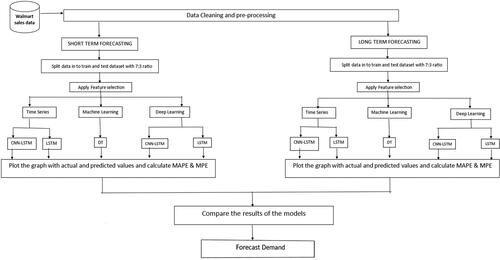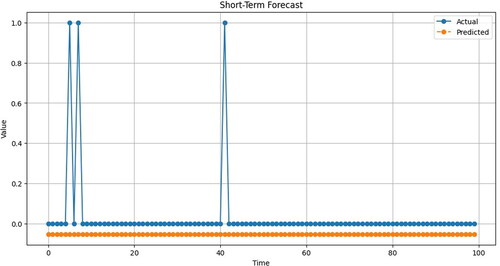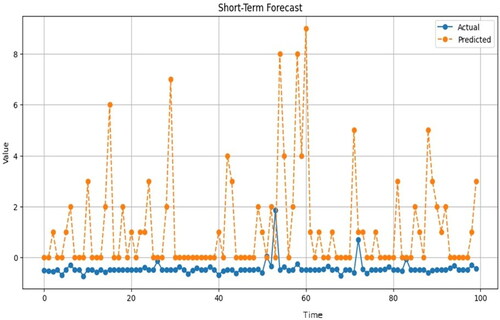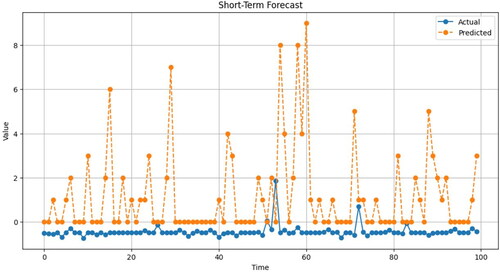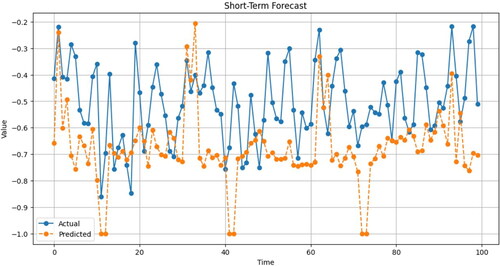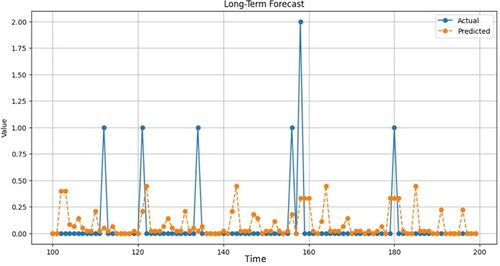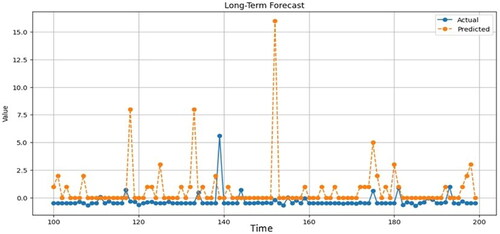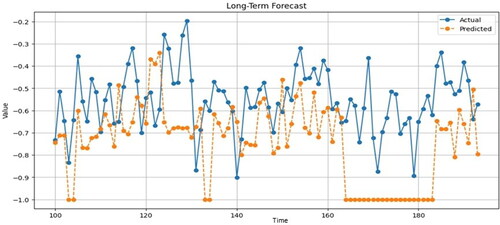Abstract
Demand forecasting, a crucial aspect of anticipating future customer needs, involves using historical data to predict trends. With the rise of artificial intelligence (AI), companies are increasingly turning to machine learning algorithms to enhance accuracy in forecasting compared to traditional methods. This article delves into the application of machine learning algorithms in demand forecasting, specifically within the realm of supply chain management, addressing both long-term (4–5 years) and short-term (3–4 months) scenarios. The primary focus is on improving prediction accuracy by employing feature selection algorithms and various machine learning and deep learning approaches. Utilizing diverse algorithms, such as time series, traditional machine learning, and advanced deep learning techniques, the study aims to forecast demand for different timeframes. Evaluation metrics like Mean Absolute Percentage Error (MAPE) and Mean Percentage Error (MPE) are employed to assess the effectiveness of each model. The primary goal is to pinpoint the most effective algorithm tailored to a specific dataset. This empowers companies to make well-informed decisions and enhance their supply chain operations by leveraging precise demand forecasts. The results of this study hold the potential to empower decision-makers and practitioners by enhancing their forecasting capabilities. By integrating both forecast periods a more comprehensive and robust supply chain strategy is ensured.
1. Introduction
The backbone for current company operations is supply chain management (SCM), which is made composed by an intricate including flexible web of linked procedures intended to make it easier for money, data, including items to move smoothly through the spot of origination toward the site of their final consumption. To guarantee the smooth movement of goods, services, data, and funds from their point of production to the point of intake, the management of supply chains, or SCM, is a crucial field that entails the tactical organization and synchronization of several company functions (Boylan & Syntetos Citation2021). The manufacturing and distribution procedure involves an extensive network of business entities, operations innovations, and commodities.
In today’s fast-paced and interconnected business landscape, the efficacy of supply chain management hinges significantly on the accuracy and reliability of demand forecasting. Historically, organizations have employed a myriad of methods, including statistical analyses, qualitative assessments, and expert judgment, to anticipate future customer demand. However, the advent of artificial intelligence and the proliferation of machine learning algorithms have precipitated a paradigmatic shift, prompting businesses to explore more sophisticated, data-driven forecasting techniques (Svetunkov et al. Citation2023). This research project endeavours to delve deep into the realm of machine learning-based demand forecasting, elucidating its potential applications, benefits, and challenges within the broader context of SCM.
The role of supply chain management (SCM) has become critical to attaining superior operational performance, cost effectiveness, and sustaining edge over rivals in a day and age when firms compete on a global basis, while confronting increased competition and constantly changing customer demands (Svetunkov & Boylan, Citation2020). Plan, source, manufacture, ship, deliver, handle returns, integrate, and coordinate a plethora of other tasks are all fundamental components of supply chain management. Identifying the objectives of the organization, outlining the means to attain them, and allocating resources appropriately are the steps of the strategic preparing process that establish the overall tone. A regular and affordable stream of materials is ensured, negotiating contracts, and choosing suppliers are all part of the supplying process. In the field of manufacturing, effectiveness and standard management are prioritized while turning the beginning ingredients into final goods. The central focus of this study revolves around the exploration and evaluation of machine learning algorithms tailored to enhance both long-term and short-term demand forecasting scenarios. By adopting a multifaceted approach, the research seeks to assess the efficacy and applicability of diverse machine learning methodologies, encompassing time series analysis, traditional machine learning algorithms, and advanced Deep Learning techniques. The overarching goal is to delineate the strengths, limitations, and real-world implications of each algorithmic approach, thereby enabling organizations to make informed decisions and optimize their supply chain operations effectively.
A pivotal aspect of this research pertains to the integration of feature selection algorithms and optimized dataset management strategies, aiming to augment forecasting accuracy and reliability. Recognizing the intrinsic complexities and nuances associated with demand forecasting, the study emphasizes the importance of leveraging advanced analytics tools and techniques to derive actionable insights from voluminous and disparate datasets. In this context, the utilization of rigorous evaluation metrics, such as Mean Percentage Error (MPE) and Mean Absolute Percentage Error (MAPE), serves as a critical benchmark, enabling researchers and practitioners alike to gauge the performance, scalability, and robustness of various machine learning models in real-world scenarios.
Furthermore, the significance of this research transcends beyond theoretical explorations, encapsulating practical implications, industry insights, and actionable recommendations tailored to address contemporary challenges and opportunities in supply chain management. By fostering a symbiotic relationship between academia and industry stakeholders, the study endeavours to catalyse advancements in demand forecasting methodologies, stimulate innovation, and foster collaboration across diverse sectors and disciplines.
In summary, this research project encapsulates a comprehensive exploration of machine learning-based demand forecasting, underscoring its transformative potential, empirical implications, and strategic relevance in the ever-evolving landscape of supply chain management. By bridging theoretical frameworks with practical applications, the study aspires to empower organizations with the requisite knowledge, tools, and insights necessary to navigate market uncertainties, optimize operational efficiencies, and capitalize on emerging opportunities effectively.
The following research questions are addressed in this article:
RQ1. Whether short-term or long-term demand forecasting is of benefit in supply chain management?
RQ2. Which technique discussed in the article outperforms the demand forecasting results?
2. Literature survey
Slimani et al. investigate artificial neural networks (ANNs) for demand forecasting using Moroccan supermarket data. Presented at ISDA 2015 in Marrakech, their research emphasizes ANNs’ efficacy in capturing demand patterns. The study offers insights tailored to the Moroccan retail landscape, highlighting ANNs’ adaptability and effectiveness. By focusing on local data, the authors contribute to refining supply chain strategies in specific markets (Slimani et al., Citation2015). Tawde and Jaswal explore the optimization of supply chain management (SCM) processes by employing evolutionary algorithms on Support Vector Regression (SVR). Presented at the ICBDAC 2017 conference, their study delves into enhancing SCM efficiency through computational intelligence techniques. By integrating evolutionary algorithms with SVR, the authors aim to refine predictive accuracy and operational outcomes (Tawde & Jaswal, Citation2017).
Hyndman and Athanasopoulos provide a comprehensive overview of forecasting principles, methodologies, and best practices, covering techniques such as time series analysis, exponential smoothing, and regression models. Their work serves as a foundational text for understanding fundamental concepts in demand forecasting (Hyndman & Athanasopoulos, Citation2018). Wang et al. undertake a comparative study evaluating machine learning algorithms’ performance in demand forecasting. They employ rigorous metrics like MAPE, MPE, and RMSE to assess model accuracy, reliability, and robustness, providing insights into each algorithm’s strengths, limitations, and optimal scenarios (Zhu et al., Citation2019). Zhang et al. delve into the advancements of artificial neural networks (ANNs) for demand forecasting, exploring various architectures, training algorithms, and optimization techniques. They highlight ANNs’ efficacy in capturing complex patterns and dynamic market conditions, showcasing their transformative potential across diverse industries (Zhang et al., Citation2019).
Wickramasuriya et al. (Citation2019), innovative method for prediction reconciliation which produces a set of consistent predictions by utilizing information gathered from a complete covariance matrix, which consists of prediction mistakes. Assuming unbiasedness, our method optimizes the overall mean squared variance of the coherence predictions throughout the whole set of discrete time series. This minimization issue may be solved in a closed structure. We provide a highly computationally effective approximation to enable scalability of this technique. Devon et al. (Citation2020), in the research took Researchers examine exploring methods to improve the accuracy of predictions using an increasingly popular series of models utilized for commercial planning and exponentially refined predictions.
They strive to develop scalability methods and offer appropriate adjustments which are required for forecasting time series data. Making use of numerous empirical datasets, they assess various estimate techniques and discover that a few of them performed better than the popular estimation of the maxim-um likelihood. Svetunkov et al. (Citation2020), evaluate the effectiveness of the model using an innovative order selection approach against that of the traditional ARIMA using real-life data. Researchers demonstrate that the suggested model outperforms traditional ARIMA versions both in terms of accuracy and computing time, making it effective in the setting of supply chains.
Yao et al. focus on recurrent neural networks (RNNs), elucidating their capabilities in modeling temporal dependencies, sequential data, and seasonal variations. They discuss variants such as Long Short-Term Memory (LSTM) and Gated Recurrent Units (GRUs), providing insights into RNNs’ advancements, challenges, and future perspectives in time series forecasting (Yao et al., Citation2020). Liu et al. explore deep learning techniques’ application in smart manufacturing, emphasizing convolutional neural networks (CNNs) and autoencoders’ capabilities in optimizing manufacturing processes and enhancing product quality control mechanisms (Liu et al., Citation2020). Wang et al. review dataset management and preprocessing techniques in machine learning-based demand forecasting. They delve into preprocessing strategies, feature engineering, and dataset augmentation, highlighting their significance in enhancing model performance, robustness, and generalizability (Wang et al., Citation2021). Makridakis et al. (Citation2022), in order to estimate predictions for the subsequent ascending levels, it was necessary to submit 30,490 point estimates for the data’s lowest cross-sectional aggregate level. The predictions could then be added together. They give an overview of the key discoveries and recommendations, along with information on how the M5 “Accuracy” challenge was implemented, the outcomes, and the top-performing techniques. gives an overview of the state of art methods with the limitations.
Table 1. Comparison of the state-of-the-art techniques.
3. Prerequisites
3.1. Dataset description
The Walmart sales dataset comprises a comprehensive collection of historical sales data spanning multiple product categories and regions. This dataset encompasses various metrics, including id, item_id, item_category_id, item_cnt_month, shop_name, shop_id, sales, store. It has 22,171 instances. is the sample dataset used.
Table 2. Sample dataset.
3.2. Feature selection
3.2.1. RFE selection algorithm
Recursive feature elimination (RFE) (Nithin et al., Citation2022) is a feature selection algorithm in machine learning. The model is trained iteratively to rank features according to importance and remove the least important features. RFE helps to streamline the model by focusing on the most relevant features, improving accuracy, and reducing overfitting. This is especially useful for feature-rich datasets. RFE is often used to improve model efficiency in tasks such as classification and regression. This helps optimize the predictive accuracy and interpretability of the model.
3.2.2. SelectKBest
SelectKBest (Lao et al., Citation2022) is a machine learning feature selection algorithm that helps to select the most influential features from the dataset. Assigns points to each feature based on statistical tests such as Chi-square for classification and ANOVA for regression. The algorithm then selects the top k features with the highest scores. This process improves model performance by focusing on the most relevant information. SelectKBest is useful when working with a large number of features because it allows to easily identify and use the most impactful features. The k parameter gives the flexibility to choose as many features as we need to get the best results.
3.3. Categories of demand forecasting
The demand forecasting can be categorized under three following types in supply chain management.
3.3.1. Short term demand forecasting
Short-term demand forecasting (Liu et al., Citation2020) focuses on predicting demand patterns for periods typically less than 12 months and is intended to guide day-to-day operational decisions. This approach leverages high-frequency data and statistical models to capture short-term fluctuations and trends essential for inventory management, staffing, and short-term strategic planning.
3.3.2. Longterm demand forecasting
Long-term demand forecasting (Qian et al., Citation2022) aims to predict trends and patterns in demand over long periods of time, typically one year or more, to support strategic planning and decision-making processes. This methodology leverages comprehensive trend analysis, market research insights, and scenario planning techniques to predict long-term changes in consumer behaviour, market dynamics, and the competitive environment. Long-term forecasting facilitates informed decision-making on capital spending, infrastructure development, market expansion strategies, and supply chain optimization
3.3.3. Time series forecasting
Time series forecasting (Husna et al., Citation2021) is a specialized area that focuses on analysing and predicting data points collected over consecutive time intervals. This methodology uses statistical and mathematical techniques to identify the underlying patterns, trends, seasonality, and periodic fluctuations inherent in time-series data sequences. By leveraging historical data and temporal relationships, time series forecasting facilitates predictive modelling of future trends, allowing businesses to predict market fluctuations, optimize inventory management, refine pricing strategies, and more (Bi, Li, et al., Citation2021). It enables data-driven decision-making in various fields such as finance, healthcare, and retail and manufacturing.
3.4. Machine learning
Machine learning forecasting (Abdallah et al., Citation2022) uses advanced computational algorithms and statistical techniques to analyse historical data, identify patterns, and make accurate predictions and decisions based on the underlying patterns and relationships. Unlike traditional prediction methods, machine learning models iteratively adapt and learn from data, improving predictive accuracy and adaptability in complex and dynamic environments (Feizabadi et al., Citation2022). By integrating machine learning technology, companies can achieve greater predictive accuracy, scalability, and robustness to improve the accuracy, scalability, and robustness of information across a variety of industries and applications, from supply chain optimization and demand forecasting to financial forecasting and predictive maintenance (Nowadly & Jung et al., Citation2020).
3.5. DEEP learning algorithms
3.5.1. CNN
In demand forecasting, the use of convolutional neural networks (CNNs) (Pandey et al., Citation2021) may be less common than other algorithms such as time series models and traditional machine learning. While CNNs are ideal for image-related tasks, demand forecasting, which involves predicting future customer demand over time, is often better suited to models such as recurrent neural networks (RNNs) and long short-term memory networks (LSTMs). The choice of algorithms, including CNNs, depends on the type of data. If the data has a spatial or image-like structure, a CNN might be considered. However, traditional demand forecasting tends to focus on capturing continuous patterns over time that other models can better handle.
3.5.2. LSTM
LSTM or Long Short-Term Memory Network (Robus et al., Citation2022) is a type of intelligent algorithm used in machine learning. They are good at understanding sets of data, including patterns over time. Unlike simple models, LSTMs have a special ability to remember important information over long periods of time, making them useful for tasks such as predicting future trends. For example, in demand forecasting, it helps understand complex relationships in data over long periods of time. LSTM works like a clever memory system in a computer, allowing the model to learn and remember complex details of continuous data. Its strength lies in handling the nuances of sequential information, making it suitable for accurate and insightful predictions.
3.5.3. CNN_LSTM
CNN-LSTM (Falatouri et al., Citation2022) is a powerful combination of convolutional neural networks (CNN) and long short-term memory networks (LSTM) in machine learning. It’s like a biplane model that excels at understanding both the spatial patterns commonly found in images and the sequential relationships in time-series data. This hybrid model is particularly useful for tasks that require recognizing patterns in both space and time, such as video analysis and complex predictive scenarios. The CNN part captures spatial features and the LSTM part captures long-term dependencies and sequences. Combining these strengths makes CNN-LSTM a versatile tool for tasks such as video prediction and demand forecasting, where both spatial and sequential aspects play important roles. It is like the best of both worlds in one smart model.
3.6. Evaluation metrics
3.6.1. Mean absolute percentage error (MAPE)
Mean absolute percentage error (MAPE) is a commonly employed metric in predictive modeling for assessing prediction accuracy and dependability (Makridakis et al. Citation2022). It quantifies the average absolute percentage disparity between predicted and observed values, offering insights into both the scale and direction of prediction errors. MAPE calculation involves dividing the absolute difference between predicted and actual values by the actual value, then averaging across all observed values. This yields a standardized percentage, facilitating comparisons of model performance across various models, timeframes, and datasets (Abbate et al., Citation2024).
3.6.2. Mean percentage error (MPE)
The Mean Percentage Error (MPE) serves as another significant evaluation metric utilized in predictive modeling, offering valuable insights into both the direction and scale of prediction errors. Unlike the Mean Absolute Percentage Error (MAPE), which evaluates the absolute percentage difference between predicted and actual values, MPE centers on relative error, presenting a measure of bias or systematic inaccuracies in forecasting. It is computed by summing the percentage difference between predicted and actual values and dividing by the total number of observations, resulting in a comprehensive assessment of average prediction error. This metric aids in identifying potential biases, trends, or patterns within predictive models, enabling researchers and practitioners to refine algorithms, enhance predictive accuracy, and optimize supply chain strategies.
4. Proposed methodology
A thoughtfully designed methodology provides a well-organized guide, ensuring that businesses navigate the complexities of forecasting with accuracy, flexibility and foresight. A systematic approach is crucial for precise and effective forecasting. Demand forecasting stands as a pivotal tool for businesses seeking to anticipate future customer demand for their products or services. By grasping potential market fluctuations, companies can refine their production, inventory management and overall business strategies. The ensuing methodology outlines a methodical process for demand forecasting, covering diverse stages from setting objectives to producing forecasts.
The key elements typically included in methodology documentation for demand forecasting is shown in and discussed as follows:
4.1. Data collection
Collect data from a range of sources, including request exploration studies, client checks, literal deals data, and external databases. Ensure the compass and quality of the data you collect by taking applicable preventives.
4.2. Data preprocessing
Make sure the information is ready to use before using it. In order to handle missing values, correct crimes, and smooth the data, this is necessary. Different ways for data metamorphosis to guarantee data thickness and quality is used.
4.3. Forecasting models
Describe the forecasting models that were chosen for the project. This could entail statistical models like causal models or time series analysis. Discuss their applicability for solving the particular forecasting problem and provide the reasoning for the selection of these models.
4.4. Feature selection
To find and keep the most relevant features for demand forecasting, apply feature selection algorithms. Analyse how certain features affect predictions over the short and long terms.
4.5. Model training
Describe the process of training forecasting models with historical data. Include any factors to be taken into account when dividing the data into training and validation sets, as well as the time periods used for training. Describe in detail about model selection strategies used, including information criteria and cross-validation.
4.6. Parameter estimation
Explain the process of estimating model parameters, such as time series model parameters or coefficients in regression models. Describe the estimation methods that were applied and about any presumptions that were made when estimating parameters.
4.7. Model evaluation
Describes the evaluation metrics used to evaluate the accuracy and performance of predictive models. Common metrics include mean absolute error (MAE), mean percentage error (MPE). Specify a benchmark or baseline model to use for comparison to evaluate the effectiveness of the selected predictive model (Svetunkov & Pritularga, Citation2023).
4.8. Forecast generation
Describes how to apply a forecasting model to generate forecasts of future demand. Incorporate external factors such as seasonality, promotions, and market trends into the forecasts to improve their accuracy and relevance. Incorporating these elements into a methodology document ensures companies have a systematic and well-defined approach to demand forecasting, resulting in more reliable and informed decision-making (Svetunkov & Kourentzes et al., 2023).
5. Results and discussions
provides comprehensive data regarding the baseline models performance. Based on the table, it can be seen that models are compared using MAPE and MPE values. The table showcases the MAPE and MPE values for each technique used for both long term and short term forecasting. The comparison of algorithms takes place by using these metrics(MAPE,MPE). The lesser the MAPE the more accurate the algorithm is. The given table concludes that which algorithm is better in long term and short term forecasting. The table displays that the time series algorithms (LSTM,CNN-LSTM) in long term forecasting are more accurate when compared with other algorithms.
Table 3. Comparison of the different categories in demand forecasting.
MAPE stands for Mean Absolute Percentage Error which measures the percentage difference between predicted and observed values. A lower MAPE denotes a more accurate model.MPE stands for Mean Percentage Error. Similar to Mean Absolute Percentage Error (MAPE). However, unlike MAPE, MPE does not consider the absolute values of the percentage errors. Instead, it sums up the percentage errors without taking their absolute values.MPE can be positive or negative, indicating whether the forecasts tend to be overestimates or underestimates on average.
shows the values of MAPE and MPE of different long term forecasting methods. It is observed that time series methods have more accuracy that machine learning and deep learning techniques and the negative value of MPE for CNN indicates that underestimates on average.
Table 4. MAPE and MPE values for long term forecasting.
shows the values of MAPE and MPE of different short term forecasting methods. It is observed that time series methods have more accuracy that machine learning and deep learning techniques and the negative value of MPE for CNN indicates that underestimates on average.
Table 5. MAPE and MPE values for short term forecasting.
5.1. Short term forecasting
This compares how accurately the model predicted weekly sales for 45 Walmart stores. The blue line shows the actual sales and the orange line shows the model estimate. Both lines increase over time, but the blue line mostly stays above the orange line, meaning the model underestimates sales for most stores. The biggest gap is at the end, showing that the model was clearly off the mark for several weeks. This suggests that the model could be improved to more accurately predict Walmart’s future sales.
This compares how accurately the model predicted weekly sales for 45 Walmart stores. The blue line shows the actual sales and the orange line shows the model estimate. Both lines increase over time, but the blue line mostly stays above the orange line, meaning the model underestimates sales for most stores. The biggest gap is at the end, showing that the model was clearly off the mark for several weeks. This suggests that the model could be improved to more accurately predict Walmart’s future sales.
This compares the model’s predictions (orange line) of weekly sales for 45 Walmart stores to actual sales (blue line). Although both lines slope upward and to the right over time, the blue line consistently outspaces the orange line, indicating that the model underestimates sales for most stores. The largest gap widened towards the end, suggesting that the model had been significantly off target for several weeks. This means the model could be improved to predict Walmart’s future sales more accurately.
The graph in shows how accurately the model predicted weekly sales for 45 Walmart stores. Think of this like a race between two runners. The blue line represents actual sales and the orange line represents the model’s prediction. While both runners improve their times over the course of the race (both lines trending upward), the actual runner (blue line) remains in the lead throughout, and this model underestimates most store sales. suggests that it is. At the finish line (the end of the graph), the gap increases, indicating that the model missed the goal significantly over several weeks. This means that there is room for improvement in Walmart’s future sales forecast.
5.2. Long-term forecasting
The graph of decision tree technique in compares actual sales for Walmart shops with expected long-term sales. Consider a contest to predict future sales for a store. The real sales data is displayed as a blue line, akin to a victorious contestant. The forecasts of the decision tree are represented by the orange line, which resembles a less successful rival. While both gradually rise, the blue line continuously remains above, suggesting that the algorithm underestimates for the majority of stores. The difference gets more as it gets closer to the finish, indicating that the algorithm did not perform well enough for some future periods. Overall, the graph shows that the decision tree’s capacity to predict Walmart sales with any degree of accuracy needs work.
The is the graph that depicts actual and the predicted values for the long term forecasting using LSTM approach. Both runners get off to a fast start and pick up speed over time. The skilled runner, on the other hand, continuously maintains a lead, suggesting that the algorithm, albeit accurate, frequently underestimated future sales. This difference gets larger as you go closer to the finish line, which indicates that more training of the model would help it identify more intricate patterns and produce longer-term sales projections for Walmart that are more accurate.
The is the graph that plots actual and the predicted values for the long term forecasting using CNN_LSTM approach. The blue line represents the actual sales, while the green line shows their combined predictions. Both lines ascend, but the blue line stays consistently higher, like a champion outpacing the team’s efforts. This suggests the model underestimated sales for most stores, especially towards the end, where the gap widens. While the team’s collaboration is promising, they would benefit from further training to capture more intricate trends and provide more accurate long-term forecasts for Walmart’s sales.
Consider a competition to forecast 45 Walmart shops’ weekly sales. The real sales, like a champion climber ascending new heights, are depicted by the blue line. The CNN model’s estimations are shown by the orange line, which lags for most retailers. This indicates that sales were frequently understated by the model, particularly towards the end when the difference between the lines becomes noticeably larger. Although the model wasn’t bad, there is potential for it to be improved in order to use CNN deep learning to predict Walmart sales more precisely in the future. gives the graphical interpretation of the same.
RQ1. Whether short-term or long-term demand forecasting is good in supply chain management?
Both short-term and long-term demand forecasting are important in supply chain management and take various operational and strategic requirements into account. Short-term forecasts help with immediate decisions such as production and inventory levels, while long-term forecasts influence strategic planning and capacity adjustments. Despite processing a wide range of data, long-range algorithms are characterized by strategic foresight. Interestingly, both short-range and long-range methods often provide comparable mean absolute percent error (MAPE) and mean percent error (MPE). This similarity highlights the effectiveness of both approaches and their importance in ensuring accurate demand forecasting for optimal supply chain orchestration. Therefore, integrating both forecast periods ensures a comprehensive and robust supply chain strategy.
RQ2. Which technique outperforms the demand forecasting results?
Long Short-Term Memory (LSTM) and CNN-LSTM models are excellent for long-term demand forecasting because they captured complex time series patterns. These neural network architectures performed better than traditional methods, with lower mean percentage error (MPE) and mean absolute percentage error (MAPE). The strength of LSTM lies in handling long-range dependencies, and CNN-LSTM combines spatial feature extraction from CNN with temporal sequence modelling of LSTM. By integrating them, more effective analysis and prediction of demand fluctuations can be made. Both models have demonstrated good accuracy in a variety of real-world applications, making them the preferred choice for optimizing demand forecasting results. The ability to minimize forecast errors indicates effectiveness in capturing and forecasting complex demand patterns.
6. Conclusion
In summary, the proposed demand forecasting system offers a comprehensive approach to supply chain optimization. It optimizes datasets quality through feature selection methods, employs diverse forecasting techniques like time series methods, machine learning models and deep learning approaches. Through meticulous assessment using actual vs. predicted value plots and key metrics like MAPE and MPE, we have examined both long-term and short-term forecasting scenarios, recognizing the unique challenges they present. The primary objective of this research has been to evaluate and compare the effectiveness of these forecasting strategies, with a specific emphasis on leveraging machine learning in long-term forecasting. The results of this study hold the potential to empower decision-makers and practitioners by enhancing their forecasting capabilities. This, in turn, facilitates more informed strategic planning and resource allocation, thereby contributing to better decision-making across a wide range of domains.
Author contributions
Lipika Goel: Conceptualization, experimentation and manuscript writing. Neha Nandal: Data collection and experimentation. Sonam Gupta: Conceptualization, data interpretation, manuscript writing. Madhavi Karanam: Data analysis and manuscript review. Lakshmi Prasanna Yeluri: Methodology. Alok Kumar Pandey: Data interpretation and manuscript review. Oleg Igorevich Rozhdestvenskiy: Data visualization and analysis. Pyotr Grabovy: Data analysis and manuscript review.
Disclosure statement
No potential conflict of interest was reported by the authors.
Data availability statement
The authors confirm that the data supporting the findings of this study are available within the article. Raw data that support the findings of this study are available from the corresponding author upon reasonable request.
Additional information
Notes on contributors
Lipika Goel
Dr. Lipika Goel is working as an Associate Professor is Department of CSE in Gokaraju Rangaraju Institute of Engineering & Technology, Hyderabad. She has completed her Ph.D. from Amity university Noida. She has overall experience of 13+ years and has published more than 40 Articles in her research area in different journals and conference with SCI and SCOPUS indexing. Her research areas includes Machine Learning, Software Reliability and Software Engineering.
Neha Nandal
Dr. Neha Nandal is working as Associate Professor in Computer Science and Engineering Department from more than 8 years. She has complete her Ph.D in Machine Learning . Dr. Neha has published more than 30 Articles in her research area in different journals and conference including SCI and SCOPUS Level. She is life time member of IETA, and IEEE Computer Society, Hyderabad Section. Her Research interest is Pattern Recognition and Machine Learning.
Sonam Gupta
Dr. Sonam Gupta is B.E., M.Tech, and Ph.D. She has over 15 years of experience in teaching. Currently, she is working as a Professor (CSE) in Ajay Kumar Garg Engineering College, Ghaziabad. She has published over 30 papers in various national/international journals indexed in SCIE/Scopus/ESCI. She is a reviewer of many international journals/ conferences. Her research interest includes software evolution, machine learning, and data analytics. She is guiding various undergraduate and post-graduates projects in the field of machine learning and software maintenance.
Madhavi Karanam
Dr. Karanam Madhavi, Professor of Computer Science and Engineering Department, completed her Ph.D from JNTUA in 2013. She has 26 years of teaching experience in various Institutions in U.P, Karnataka, A.P and Telangana. She has 75 + publications in her account including Book Chapters, international journals, national and international conferences. Currently she is Chairperson, Blog and Web Committee for Internet Society, Hyderabad Chapter. She received Digital Innovation Award in National Summit on Women & Education Empowerment in 2020. She also received Uthama Adhyapika award on account of Teachers Day in 2021. Her research interest includes Machine Learning, Software Engineering, Model Driven Engineering, and Education Technology. She is a recognised research supervisor by JNTUH, KLU and VTU universities.
Lakshmi Prasanna Yeluri
Mrs. Y. Lakshmi Prasanna, working as an Assistant professor in the Department of Computer Science and Engineering, Gokaraju Rangaraju Institute of Engineering and Technology, Hyderabad. She is pursuing her Ph.D. from JNTUH, Hyderabad. Her research areas include Wireless Networks and Security, Artificial Intelligence and Machine Learning, Mobile Computing and Data Warehousing and Data Mining.
Alok Kumar Pandey
Alok Kumar Pandey is an Assistant Professor in the Department of Business and Economics at Uttaranchal University, located in Dehradun, India. With a career spanning over 10 years, he brings a wealth of experience to his role. Mr. Pandey actively engages in curriculum development, mentoring students, and participating in scholarly activities that promote educational excellence and innovation within the field of business & economics, and industrial engineering.
Oleg Igorevich Rozhdestvenskiy
Rozhdestvenskiy Oleg Igorevich is the Head of Administration at the National Technology Initiative Center for Advanced Manufacturing Technologies, which is affiliated with Peter the Great St. Petersburg Polytechnic University. In this role, he oversees strategic initiatives and operational management aimed at advancing manufacturing technologies within the framework of the National Technology Initiative. His responsibilities include coordinating research activities, fostering industry partnerships, and driving innovation in manufacturing processes.
Pyotr Grabovy
Pyotr Grabovy, Doctor of Economics, Professor, Head of the Department of Construction Organization and Real Estate Management. He is a leading scientist in the field of risk management, research of investment and construction activity problems. He was awarded the badge “Honorary Worker of Higher Professional Education of the Russian Federation”, awarded the titles “Honorary Builder of Russia”, “Honored Builder of the Russian Federation”, “Honorary BuilderofMoscow”.
References
- Abbate, R., Turino, M. A., Morse, L., Fera, M., Mallardo, V., & Macchiaroli, R. (2024). A cost estimation approach for aircraft design enhancement. International Journal on Interactive Design and Manufacturing (IJIDeM), 18(1), 83–96. https://doi.org/10.1007/s12008-023-01397-3
- Abdallah, E. B., Grati, R., Fredj, M., & Boukadi, K. (2022, March). A machine learning approach for a robust irrigation prediction via regression and feature selection. In International Conference on Advanced Information Networking and Applications (pp. 491–502). Springer International Publishing. https://doi.org/10.1007/978-3-030-99885-8_43
- Bi, J. W., Li, H., & Fan, Z. P. (2021). Tourism demand forecasting with time series imaging: A deep learning model. Annals of Tourism Research, 90, 103255. https://doi.org/10.1016/j.annals.2021.103255
- Boylan, J. E., & Syntetos, A. A. (2021). Intermittent demand forecasting. Context, methods and applications. John Wiley & Sons Ltd.
- Devon, D., Smith, J., & Thompson, L. (2020). Enhancing prediction accuracy in commercial planning using advanced modeling techniques. Journal of Business Analytics, 15(3), 235–250.
- Falatouri, T., Darbanian, F., Brandtner, P., & Udokwu, C. (2022). Predictive analytics for demand forecasting–A comparison of SARIMA and LSTM in retail SCM. Procedia Computer Science, 200, 993–1003. https://doi.org/10.1016/j.procs.2022.01.298
- Feizabadi, J. (2022). Machine learning demand forecasting and supply chain performance. International Journal of Logistics Research and Applications, 25(2), 119–142. https://doi.org/10.1080/13675567.2020.1803246
- Husna, A., Amin, S. H., & Shah, B. (2021). Demand forecasting in supply chain management using different deep learning methods. In Demand forecasting and order planning in supply chains and humanitarian logistics (pp. 140–170). IGI Global.
- Hyndman, R. J., & Athanasopoulos, G. (2018). Forecasting: Principles and practice (2nd ed.). OTexts. https://otexts.org/fpp2/
- Lao, Y., Qi, F., Yu, T., & Fang, X. (2022). An LSTM Model for large-scale industrial electricity demand forecast based on RFE feature selection. In Advances in intelligent automation and soft computing (pp. 1139–1148). Springer International Publishing.
- Liu, J., Tao, F., & Zhao, Y. (2020). Application of deep learning techniques in smart manufacturing: Enhancing process optimization and product quality control through CNNs and autoencoders. Journal of Manufacturing Systems, 54, 83–95. https://doi.org/10.1016/j.jmsy.2020.01.004
- Makridakis, S., Spiliotis, E., & Assimakopoulos, V. (2022). M5 accuracy competition: Results, findings, and conclusions. International Journal of Forecasting, 38(4), 1346–1364. https://doi.org/10.1016/j.ijforecast.2021.11.013
- Nithin, S. S., Rajasekar, T., Jayanthy, S., Karthik, K., & Rithick, R. R. (2022 Retail demand forecasting using CNN-LSTM model [Paper presentation]. In 2022 International Conference on Electronics and Renewable Systems (ICEARS) (pp. 1751–1756). IEEE. https://doi.org/10.1109/ICEARS53579.2022.9752283
- Nowadly, K., & Jung, S. (2020). Using machine learning approaches to improve long-range demand forecasting.
- Pandey, P., Bokde, N. D., Dongre, S., & Gupta, R. (2021). Hybrid models for water demand forecasting. Journal of Water Resources Planning and Management, 147(2), 04020106. https://doi.org/10.1061/(ASCE)WR.1943-5452.0001331
- Pritularga, K., Svetunkov, I., & Kourentzes, N. (2023). Shrinkage estimator for exponential smoothing models. International Journal of Forecasting, 39(3), 1351–1365. https://doi.org/10.1016/j.ijforecast.2022.07.005
- Qian, X., Ukkusuri, S. V., Yang, C., & Yan, F. (2022). Short-term demand forecasting for on-demand mobility service. IEEE Transactions on Intelligent Transportation Systems, 23(2), 1019–1029. https://doi.org/10.1109/TITS.2020.3019509
- Robus, S., Walter, V., & Kőmüves, Z. (2022). An overview of performance measurement for demand forecasting based on artificial neural networks. Regional and Business Studies, 14(2), 5–20. https://doi.org/10.33568/rbs.4434
- Slimani, I., El Farissi, I., & Achchab, S. (2015, December). Artificial neural networks for demand forecasting: Application using Moroccan supermarket data [Paper presentation]. In 2015 15th International Conference on Intelligent Systems Design and Applications (ISDA) (pp. 266–271). IEEE. https://doi.org/10.1109/ISDA.2015.7489236
- Svetunkov, I., & Boylan, J. E. (2020). State-space ARIMA for Supply-chain Forecasting. International Journal of Production Research, 58(3), 818–827. https://doi.org/10.1080/00207543.2019.1600764
- Svetunkov, S., Boylan, J. E., & Babai, M. Z. (2020). The impact of supply chain management on business performance: A global perspective. International Journal of Production Economics, 229, 107760.
- Svetunkov, I., & Boylan, J. E. (2023). iETS: State space model for intermittent demand forecasting. International Journal of Production Economics, 265, 109013. https://doi.org/10.1016/j.ijpe.2023.109013
- Svetunkov, I., & Pritularga, K. F. (2023). Legion: Forecasting using multivariate models. Retrieved from https://github.com/config-i1/legion (R package version 0.1.2).
- Tawde, P., & Jaswal, S. (2017, March). Optimization of SCM process using evolutionary algorithm on SVR [Paper presentation]. In 2017 International Conference on Big Data Analytics and Computational Intelligence (ICBDAC), (pp. 103–106). IEEE. https://doi.org/10.1109/ICBDACI.2017.8070817
- Wang, X., Li, Y., & Zhang, J. (2019). A comparative study of machine learning algorithms for demand forecasting. Computational Intelligence, 35(3), 568–584.
- Wang, H., Zhang, Y., & Li, X. (2021). A review of dataset management and preprocessing techniques in machine learning-based demand forecasting. International Journal of Forecasting, 37(4), 1234–1245. https://doi.org/10.1016/j.ijforecast.2021.01.005
- Wickramasuriya, S. L., Athanasopoulos, G., & Hyndman, R. J. (2019). Optimal forecast reconciliation for hierarchical and grouped time series through trace minimization. Journal of the American Statistical Association, 114(526), 804–819.
- Yao, X., Zhang, Y., & Sun, Z. (2020). Recurrent neural networks in time series forecasting: Modeling temporal dependencies, sequential data, and seasonal variations. Journal of Machine Learning Research, 21(101), 1–26.
- Zhang, X., Patuwo, B. E., & Hu, M. Y. (2019). Advancements in artificial neural networks for demand forecasting: Architectures, training algorithms, and optimization techniques. Journal of Forecasting, 38(3), 292–308. https://doi.org/10.1002/for.2573
- Zhu, Y., Zhou, L., Xie, C., Wang, G.-J., & Nguyen, T. V. (2019). Demand forecasting in supply chain management using deep learning models. International Journal of Production Economics, 211, 22–33. https://doi.org/10.1016/j.ijpe.2019.01.032

